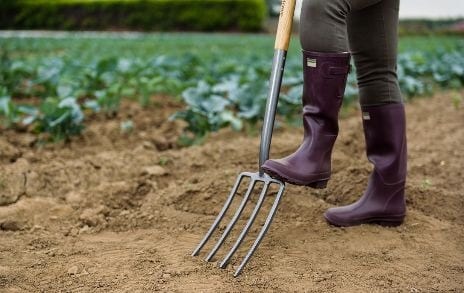The secret to success for next season is in your soil. If you cultivate and condition, feed and dress soil well, you provide a strong foundation for beautiful flowers, flowing foliage and bumper crops which last all season long. Winter is the perfect time to get cracking, too, as freezing and thawing loosens the soil and makes it easier to dig. Simply wait for a day when ground is not frozen or waterlogged, then follow these steps.
Step 1: Cultivate and cleanse
Your first job is to cultivate soil by digging down and turning it over with a garden fork, breaking up any large pieces and removing stones and weed roots as you go.

This aerates the soil, which makes it easier for plants to access vital nutrients and water, as well as removing debris and compacted clumps that can get in the way of spreading roots. Removing weeds is also essential since weeds compete with plants for water, nutrients and even light if they get big enough.
Done wrong, this work can be – quite literally – back-breaking, so take care to use the correct technique whilst digging. Your aim is to use the weight of your body and leverage of the fork’s handle to do most of the heavy lifting for you, rather than using the strength in your muscles.
Stand upright with your back straight and step your weight onto the fork’s head to push its prongs into the ground. Then, step back and push down on the handle to use the leverage of the shaft to upturn a section of earth. Use the side of the fork to break apart clumps and remove any debris by hand.
Most plants need a root depth of 15–20cm, so it is best to dig down at least this far, though you’ll want to dig to around 30cm deep if growing root vegetables. Alternatively, hire a rotavator from a local supplier and it will do all the hard work for you!
Step 2: Condition
Soil is a living thing and there are more microorganisms in a handful of garden soil than there are humans on the planet! Many microorganisms are good for your plants – they encourage resistance to disease and break down organic material, releasing nutrients in a form that can be absorbed by roots.
These beneficial organisms are promoted when you introduce oxygen into your soil by cultivating it. They also thrive in soils rich in organic matter.
So, your next step is to add in lots of organic matter to keep microorganisms thriving and, in turn, create a nutrient-rich environment for your plants.
There are lots of different kinds of organic matter to choose from. You can use composts and leaf moulds, farmyard manure and various soil conditioners available from the garden centre—these look like bags of compost and are easy to spot.

In addition to being sold at the garden centre, farmyard manure is often available along country lanes. It comes well-rotted and smell-free, so don’t be put off, it really is marvellous for your plants!
The process is simple. Dump your organic matter of choice in a heap on top of your freshly cultivated soil, use a rake to spread it evenly across your border and then dig in.
You want to spread it to a depth of about 12cm, which is about a wheelbarrow’s worth of organic matter for every square metre of soil. Digging it in will be easier now, since you’ve already loosened the soil in the plot by cultivating it.
Step 3: Feed
The next step is to feed with fertiliser to put nutrients vital for healthy plant growth directly into the soil.

You can get fertilisers for specific plant varieties, which you might opt for if you’re planning to grow an entire bed of the same plant type, however, you can’t go wrong with a general purpose NPK 7+7+7 fertiliser.
This is a fertiliser that contains equal parts of nitrogen, for healthy foliage and stem growth, phosphorous, for the development of strong roots, and potassium, for the production of quality flowers and fruits.
To incorporate fertiliser, simply sprinkle the amount recommended on the label over the surface of your soil like chicken feed and dig in.
Step 4: Dress
To finish, dress your soil with a thick layer (5-7cm) of organic mulch. Bark chippings or composted bark will look great, protect plant roots from temperature fluctuations and will further support those all-important micro-organisms in the soil. A definite winner all-round.
Take these steps to improve your soil this winter and your plants will be showing the spectacular benefits all season long.
Tip:
Mist tropical houseplants,
like orchids, bromeliads and palms,
daily to keep them happy over winter
in otherwise dry centrally
heated houses.
Reader questions
My indoor bulbs are attracting flies, what can I do?

The likely culprit here is the fungus gnat. These live in damp composts and look like flies walking over the soil’s surface or hovering around plants. They are unlikely to damage plants but can be unattractive to look at. Allowing compost to dry between watering will help reduce the problem and sticky traps designed to catch adults are available from most garden centres.
When can I grow tomatoes indoors?

If you choose the right spot and variety, anytime! Pick a warm room (18˚C+) that receives lots of natural sunlight and plant seeds of compact varieties known to perform well inside.
‘Red Robin’ and ‘Tiny Tim’ are excellent hassle-free examples – they grow well on kitchen windowsills and require no pinching out or support.

Leave A Comment